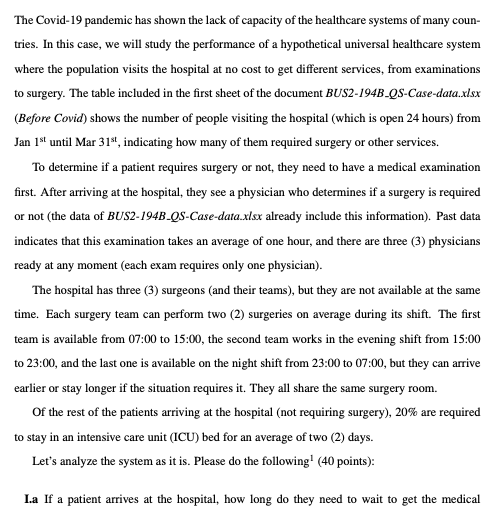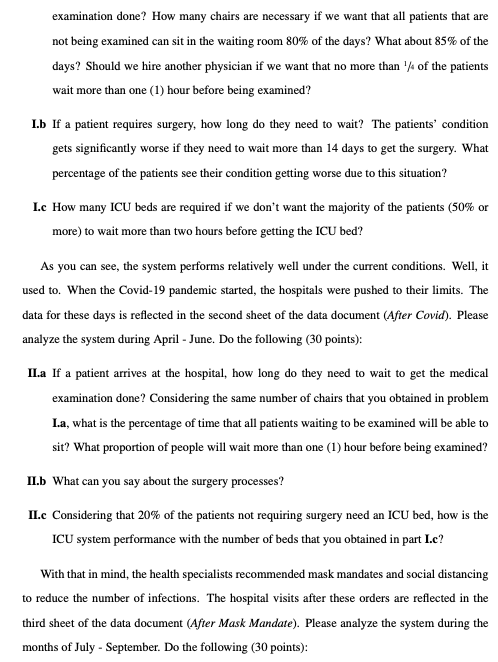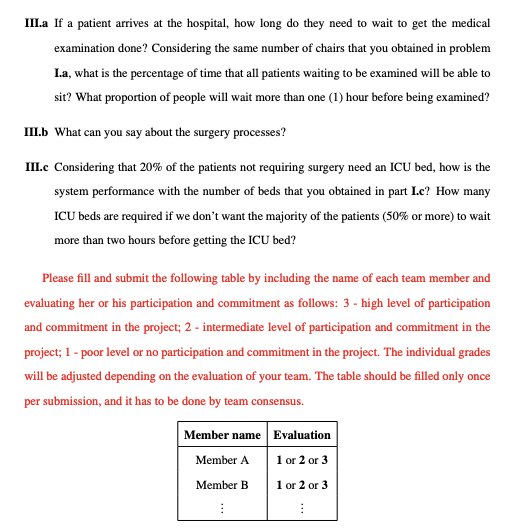


Data:



The Covid-19 pandemic has shown the lack of capacity of the healthcare systems of many countries. In this case, we will study the performance of a hypothetical universal healthcare system where the population visits the hospital at no cost to get different services, from examinations to surgery. The table included in the first sheet of the document BUS2-194B_QS-Case-data.xlsx (Before Covid) shows the number of people visiting the hospital (which is open 24 hours) from Jan 1st until Mar 31st, indicating how many of them required surgery or other services. To determine if a patient requires surgery or not, they need to have a medical examination first. After arriving at the hospital, they see a physician who determines if a surgery is required or not (the data of BUS2-194B_QS-Case-data-xlsx already include this information). Past data indicates that this examination takes an average of one hour, and there are three (3) physicians ready at any moment (each exam requires only one physician). The hospital has three (3) surgeons (and their teams), but they are not available at the same time. Each surgery team can perform two (2) surgeries on average during its shift. The first team is available from 07:00 to 15:00, the second team works in the evening shift from 15:00 to 23:00, and the last one is available on the night shift from 23:00 to 07:00, but they can arrive earlier or stay longer if the situation requires it. They all share the same surgery room. Of the rest of the patients arriving at the hospital (not requiring surgery), 20% are required to stay in an intensive care unit (ICU) bed for an average of two (2) days. Let's analyze the system as it is. Please do the following 1 ( 40 points): I. If a patient arrives at the hospital, how long do they need to wait to get the medical examination done? How many chairs are necessary if we want that all patients that are not being examined can sit in the waiting room 80% of the days? What about 85% of the days? Should we hire another physician if we want that no more than 1/4 of the patients wait more than one (1) hour before being examined? I.b If a patient requires surgery, how long do they need to wait? The patients' condition gets significantly worse if they need to wait more than 14 days to get the surgery. What percentage of the patients see their condition getting worse due to this situation? I.c How many ICU beds are required if we don't want the majority of the patients ( 50% or more) to wait more than two hours before getting the ICU bed? As you can see, the system performs relatively well under the current conditions. Well, it used to. When the Covid-19 pandemic started, the hospitals were pushed to their limits. The data for these days is reflected in the second sheet of the data document (After Covid). Please analyze the system during April - June. Do the following ( 30 points): II. If a patient arrives at the hospital, how long do they need to wait to get the medical examination done? Considering the same number of chairs that you obtained in problem I.a, what is the percentage of time that all patients waiting to be examined will be able to sit? What proportion of people will wait more than one (1) hour before being examined? II.b What can you say about the surgery processes? II.c Considering that 20% of the patients not requiring surgery need an ICU bed, how is the ICU system performance with the number of beds that you obtained in part I.c? With that in mind, the health specialists recommended mask mandates and social distancing to reduce the number of infections. The hospital visits after these orders are reflected in the third sheet of the data document (After Mask Mandate). Please analyze the system during the months of July - September. Do the following ( 30 points): III.a If a patient arrives at the hospital, how long do they need to wait to get the medical examination done? Considering the same number of chairs that you obtained in problem I.a, what is the percentage of time that all patients waiting to be examined will be able to sit? What proportion of people will wait more than one (1) hour before being examined? III.b What can you say about the surgery processes? III.c Considering that 20% of the patients not requiring surgery need an ICU bed, how is the system performance with the number of beds that you obtained in part I.c? How many ICU beds are required if we don't want the majority of the patients ( 50% or more) to wait more than two hours before getting the ICU bed? Please fill and submit the following table by including the name of each team member and evaluating her or his participation and commitment as follows: 3 - high level of participation and commitment in the project; 2 - intermediate level of participation and commitment in the project; 1 - poor level or no participation and commitment in the project. The individual grades will be adjusted depending on the evaluation of your team. The table should be filled only once per submission, and it has to be done by team consensus. Before Covid The Covid-19 pandemic has shown the lack of capacity of the healthcare systems of many countries. In this case, we will study the performance of a hypothetical universal healthcare system where the population visits the hospital at no cost to get different services, from examinations to surgery. The table included in the first sheet of the document BUS2-194B_QS-Case-data.xlsx (Before Covid) shows the number of people visiting the hospital (which is open 24 hours) from Jan 1st until Mar 31st, indicating how many of them required surgery or other services. To determine if a patient requires surgery or not, they need to have a medical examination first. After arriving at the hospital, they see a physician who determines if a surgery is required or not (the data of BUS2-194B_QS-Case-data-xlsx already include this information). Past data indicates that this examination takes an average of one hour, and there are three (3) physicians ready at any moment (each exam requires only one physician). The hospital has three (3) surgeons (and their teams), but they are not available at the same time. Each surgery team can perform two (2) surgeries on average during its shift. The first team is available from 07:00 to 15:00, the second team works in the evening shift from 15:00 to 23:00, and the last one is available on the night shift from 23:00 to 07:00, but they can arrive earlier or stay longer if the situation requires it. They all share the same surgery room. Of the rest of the patients arriving at the hospital (not requiring surgery), 20% are required to stay in an intensive care unit (ICU) bed for an average of two (2) days. Let's analyze the system as it is. Please do the following 1 ( 40 points): I. If a patient arrives at the hospital, how long do they need to wait to get the medical examination done? How many chairs are necessary if we want that all patients that are not being examined can sit in the waiting room 80% of the days? What about 85% of the days? Should we hire another physician if we want that no more than 1/4 of the patients wait more than one (1) hour before being examined? I.b If a patient requires surgery, how long do they need to wait? The patients' condition gets significantly worse if they need to wait more than 14 days to get the surgery. What percentage of the patients see their condition getting worse due to this situation? I.c How many ICU beds are required if we don't want the majority of the patients ( 50% or more) to wait more than two hours before getting the ICU bed? As you can see, the system performs relatively well under the current conditions. Well, it used to. When the Covid-19 pandemic started, the hospitals were pushed to their limits. The data for these days is reflected in the second sheet of the data document (After Covid). Please analyze the system during April - June. Do the following ( 30 points): II. If a patient arrives at the hospital, how long do they need to wait to get the medical examination done? Considering the same number of chairs that you obtained in problem I.a, what is the percentage of time that all patients waiting to be examined will be able to sit? What proportion of people will wait more than one (1) hour before being examined? II.b What can you say about the surgery processes? II.c Considering that 20% of the patients not requiring surgery need an ICU bed, how is the ICU system performance with the number of beds that you obtained in part I.c? With that in mind, the health specialists recommended mask mandates and social distancing to reduce the number of infections. The hospital visits after these orders are reflected in the third sheet of the data document (After Mask Mandate). Please analyze the system during the months of July - September. Do the following ( 30 points): III.a If a patient arrives at the hospital, how long do they need to wait to get the medical examination done? Considering the same number of chairs that you obtained in problem I.a, what is the percentage of time that all patients waiting to be examined will be able to sit? What proportion of people will wait more than one (1) hour before being examined? III.b What can you say about the surgery processes? III.c Considering that 20% of the patients not requiring surgery need an ICU bed, how is the system performance with the number of beds that you obtained in part I.c? How many ICU beds are required if we don't want the majority of the patients ( 50% or more) to wait more than two hours before getting the ICU bed? Please fill and submit the following table by including the name of each team member and evaluating her or his participation and commitment as follows: 3 - high level of participation and commitment in the project; 2 - intermediate level of participation and commitment in the project; 1 - poor level or no participation and commitment in the project. The individual grades will be adjusted depending on the evaluation of your team. The table should be filled only once per submission, and it has to be done by team consensus. Before Covid












